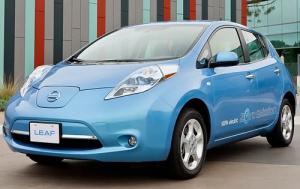- Save |
- Email |
- RSS |
- Newsletter
Forget about Who Killed the Electric Car? How about who brought it back to life? While there have been $100,000 electric sports cars and funny garage-built oddities in recent years, the Nissan Leaf is the first fully electric car that can be purchased outright, seat five people and have enough cargo space for a shopping trip. The Leaf is a real car you can buy right now, and thanks to a hefty government tax credit, it won't cost that much to do so.
With a lithium-ion battery pack providing the juice, Nissan says recharging at home with a special 220-volt charger will take 4-8 hours. A commercial quick-charge station can do it in about 30 minutes. Either way, when fully charged, the Leaf is estimated to have an effective maximum range of about 100 miles -- though just as with gas mileage, your electricity usage will vary based on driving style. Of course, that's at least three times less than the range of a gasoline-powered car, which is quicker and more convenient to refill.
As such, the Leaf is best suited for drivers who expect routine commutes or lots of trips within a short distance. Other musts include owning a garage with not only access to electricity but also a second car, since even short-distance road trips are impractical with the Leaf. Yet these caveats aren't very significant, given that millions of Americans work within 40 miles of home, own a second car and live in a house with a garage. As such, the car of the future might have truly arrived, and its name is the Nissan Leaf.
Current Nissan Leaf
The Nissan Leaf is an all-electric car introduced for 2011. There are two trim levels available, SV and SL, and both feature a generous amount of standard equipment that includes LED headlamps, keyless ignition/entry, cloth upholstery made from recycled materials, Bluetooth and an iPod interface. Also standard is Nissan Connection, a remote vehicle access system that reports recharging data and can activate the climate control via a cell phone. Optional is the highly recommended home charging station; like the car itself, it's eligible for a government tax credit.
The Leaf is powered by an 80-kilowatt electric motor fed by a 24 kWh lithium-ion battery pack. Output is 107 horsepower and 207 pound-feet of torque -- of course, you might take this information with a grain of salt, since the power delivery of an electric motor is vastly different from that of one powered by a gasoline or diesel engine.
Anyone who has driven or at least stood next to a hybrid will know how eerily quiet it can be when operating in electric mode. Well, such serenity never ceases in the Nissan Leaf, as there is only a high-pitched whine from the electric motor under heavy throttle. In such situations, there is an abundance of torque available from the first touch of the accelerator pedal, giving the Leaf an alert, energetic feel around town. This fairly heavy car also handles surprisingly well because its burden of batteries lies beneath the floor, delivering a low center of gravity that enhances agility.
With the Nissan Leaf, driving an electric car doesn't mean you have to leave people or stuff behind. This is a mainstream passenger car, not a science experiment with a cramped cabin. The rear seat is comfortable for adults, and this hatchback's cargo area can be expanded to accommodate larger items (though its load floor with the seats down is not flat). Like other alternative-fuel vehicles, the Leaf features a futuristic cabin design with split-level instruments and a center touchscreen that operates the stereo, standard navigation system and special electric system displays.
Research Models
Advertisement
New Car Resources
Advertisement
Advertisement
Recently Viewed

